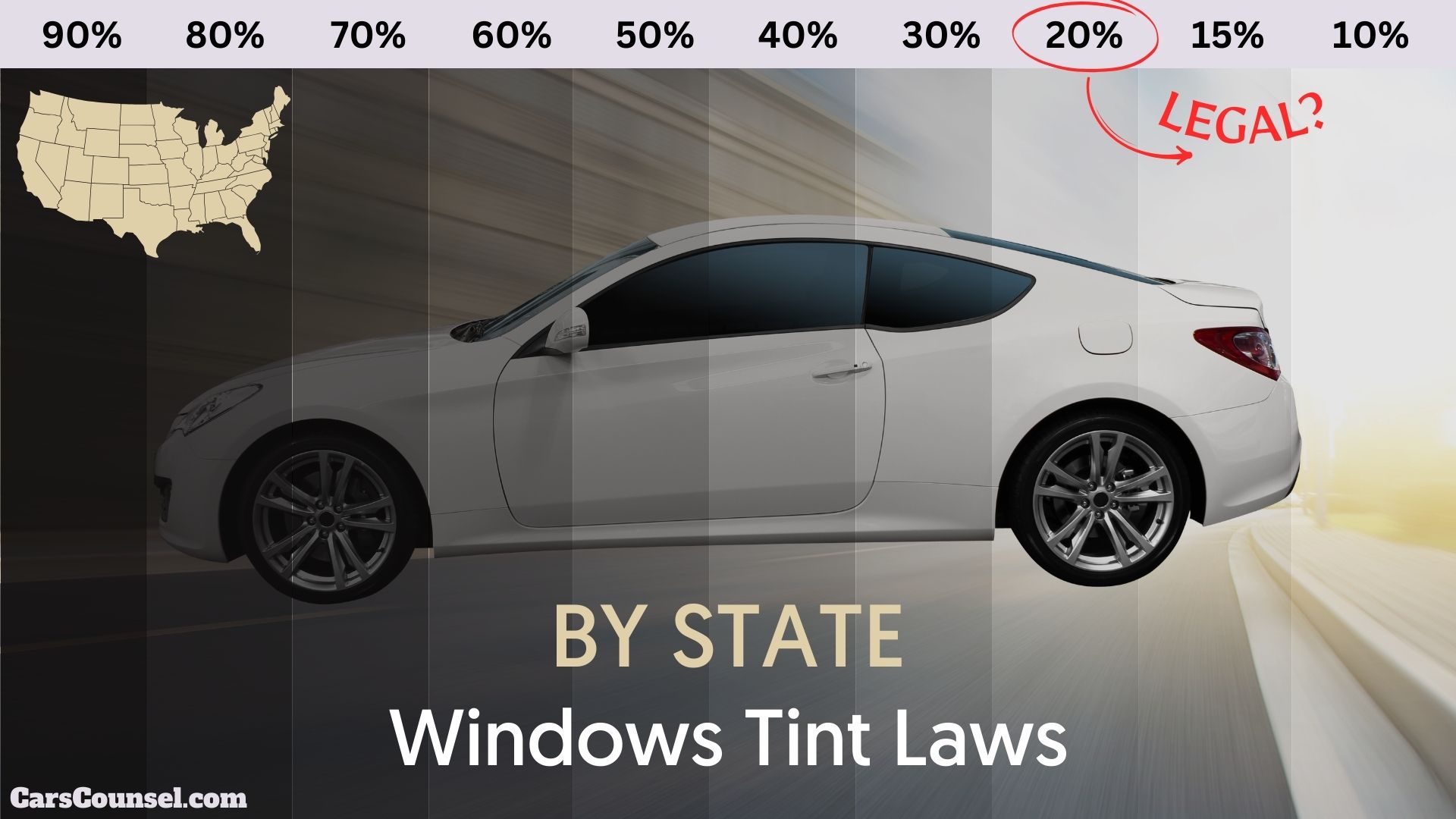Window tint laws vary wildly from state to state, and it’s astonishing how many people are unaware of the specific regulations in their area. But what exactly do these laws entail?
How dark is too dark, and what are the consequences of getting it wrong? You’re about to find out, and you must do, lest you want to risk a hefty fine or worse.

Quick Navigation
Understanding VLT Percentages
VLT percentages, which indicate the amount of visible light allowed to pass through the film. Lower VLT percentages result in darker tint shades, while higher percentages result in lighter shades.
VLT ranges vary, but common ranges include 5% for limousine-style tints, 20% for non-reflective tints, and 35% for light tints.
Understanding VLT percentages helps you choose the right tint for your vehicle while ensuring compliance with local regulations.
[adinserter block=”17″]
State-by-State Window Tint Laws
Investigate the complexities of window tint laws across the United States, where regulations vary significantly from state to state.
It’s vital to understand these regulations to avoid legal issues. By clicking on a state’s name, you’ll access a comprehensive guide to its rules and regulations.
Remember to report any incorrect data and consult local authorities to confirm compliance.
| State | Front Side Windows | Back Side Windows | Rear Windows | Windshield |
|---|---|---|---|---|
| Alabama | 32% | 32% | 32% | 6 inches |
| Alaska | 70% | 40% | 30% | 5 inches |
| Arizona | 33% | ANY | ANY | tinting allowed to the top of the manufacturer’s as-1 line |
| Arkansas | 25% | 25% | 10% | 5 inches |
| California | 70% | ANY | ANY | 4 inches |
| Colorado | 27% | 27% | 27% | 4 inches |
| Connecticut | 35% | 35% | ANY | non-reflective tint above the as-1 line top 6 inches |
| Delaware | 70% | ANY | ANY | non-reflective tint above the as-1 line top 6 inches |
| Florida | 28% | 15% | 15% | non-reflective tint above the as-1 line |
| Georgia | 32% | 32% | 32% | 6 inches |
| Hawaii | 35% | 35% | 35% | Non-reflective tint is allowed on the top 4 inches of the windshield |
| Idaho | 35% | 20% | 20% | non-reflective tint above the as-1 line |
| Illinois | 35% | 35% | 35% | 6 inches |
| Indiana | 30% | 30% | 30% | non-reflective tint above the as-1 line |
| Iowa | 70% | ANY | ANY | non-reflective tint above the as-1 line |
| Kansas | 35% | 35% | 35% | non-reflective tint above the as-1 line |
| Kentucky | 35% | 18% | 18% | non-reflective tint above the as-1 line |
| Louisiana | 40% | 25% | 12% | non-reflective tint above the as-1 line top 6 inches |
| Maine | 35% | 35% | 35% | top 4 inches |
| Maryland | 35% | 35% | 35% | top 5 inches |
| Massachusetts | 35% | 35% | 35% | top 6 inches |
| Michigan | 35% | ANY | ANY | top4 inches |
| Minnesota | 50% | 50% | 50% | Top 6 inches |
| Mississippi | 28% | 28% | 28% | non-reflective tint above the as-1 line top 5 inches |
| Missouri | 35% | ANY | ANY | non-reflective tint above the as-1 line top 6 inches |
| Montana | 24% | 14% | 14% | non-reflective tint above the as-1 line top 6 inches |
| Nebraska | 24% | 20% | 20% | top 6 inches or as-1 line, whichever comes first |
| Nevada | 35% | ANY | ANY | non-reflective tint above the as-1 line top 6 inches |
| New Hampshire | 35% | 35% | 35% | Allowed for the manufacturer’s AS-1 line |
| New Jersey | Illegal | ANY | ANY | Top 6 inches |
| New Mexico | 20% | 20% | 20% | 5 inches or as-1 line, whichever comes first |
| New York | 70% | 70% | 70% | top 6 inches |
| North Carolina | 35% | 35% | 35% | non-reflective tint above the as-1 line top 6 inches |
| North Dakota | 50% | ANY | ANY | Top 6 inches |
| Ohio | 50% | ANY | ANY | Top 5 inches |
| Oklahoma | 25% | ANY | ANY | 5 inches or as-1 line, whichever comes first |
| Oregon | 35% | 35% | 35% | Top 6 inches |
| Pennsylvania | 70% | 70% | 70% | Top 3 inches |
| Rhode Island | 70% | 35% | 35% | non-reflective tint above the as-1 line top 6 inches |
| South Carolina | 27% | 27% | 27% | non-reflective tint above the as-1 line top 6 inches |
| South Dakota | 35% | 20% | 20% | non-reflective tint above the as-1 line top 6 inches |
| Tennessee | 35% | 35% | 35% | non-reflective tint above the as-1 line top 6 inches |
| Texas | 25% | 25% | 25% | 5 inches or as-1 line, whichever comes first |
| Utah | 43% | ANY | ANY | non-reflective tint above the as-1 line top 4 inches |
| Vermont | 70% | ANY | ANY | ILLEGAL |
| Virginia | 50% | 35% | 35% | non-reflective tint above the as-1 line top 6 inches |
| Washington | 24% | 24% | 24% | Top 6 inches |
| West Virginia | 35% | 35% | 35% | Top 5 inches |
| Wisconsin | 50% | 35% | 35% | non-reflective tint above the as-1 line top 6 inches |
| Wyoming | 28% | 28% | 28% | Top 5 inches or as-1 line, whichever comes first |
Navigating Local Regulations
As you explore state-by-state window tint laws, you’ll find that local regulations add another layer of complexity.
Local compliance is vital, as window tint laws can vary by city or county, even within the same state.
It’s essential to understand both state and local laws to avoid tinting consequences, such as traffic citations or fines.
Failure to comply with local regulations can result in legal issues, even if your tint is legal at the state level.
Don’t assume that what’s legal in one city is legal in another.
Take the time to investigate local ordinances to guarantee your window tint meets the necessary standards.
Medical Exemptions and Exceptions
In certain situations, drivers may require darker window tints for medical reasons, and some states accommodate these needs through exemptions and exceptions. If you have a medical necessity that requires a darker tint, you may be eligible for an exemption. This can include conditions like sun sensitivity or skin disorders.
| State | Medical Exemption Availability |
|---|---|
| Arizona | Yes, with a certified medical application submitted to the Medical Review Program |
| Arkansas | Yes, any medical condition attested by a physician |
| California | Yes, with physician’s letter (clear tint only) |
| Connecticut | Yes, permits 20% VLT with validated form |
| Florida | Yes, for conditions like lupus and albinism with a non-expiring certificate |
| Georgia | Yes, requires physician/optometrist attestation and 23% minimum VLT |
| Louisiana | Yes, for albinism/lupus/porphyria via affidavit and decal |
| Maryland | Yes, with physician’s written certification carried in the vehicle |
| Michigan | Yes, requires physician’s letter and limits light reflection to <35% |
| New Hampshire | Yes, for melanoma/lupus with 35% VLT and 2-year validity |
| New Jersey | Yes, specific dermatological/ophthalmic conditions with 4-year renewals |
| New York | Yes, for albinism/porphyria with physician’s statement |
| North Carolina | Yes, permits 70% windshield VLT with state-issued sticker |
| Tennessee | Yes, requires medical review board approval and displayed certificate |
| Texas | Yes, medical exemption statement required during vehicle inspections |
It’s essential to research your state’s specific laws and regulations regarding medical exemptions for window tint. You may need to provide documentation from a medical professional to support your claim. Remember to always check with your local authorities to guarantee compliance with state and local laws, and to certify adherence to state and local laws.

